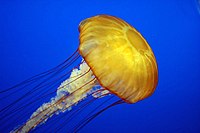
Photo from wikipedia
Investigating the effects of climatic variability on biological diversity, productivity, and stability is key to understanding possible futures for ecosystems under accelerating climate change. A critical question for estuarine ecosystems… Click to show full abstract
Investigating the effects of climatic variability on biological diversity, productivity, and stability is key to understanding possible futures for ecosystems under accelerating climate change. A critical question for estuarine ecosystems is, how does climatic variability influence juvenile recruitment of different fish species and life histories that use estuaries as nurseries? Here we examined spatiotemporal abundance trends and environmental responses of 18 fish species that frequently spend the juvenile stage rearing in the San Francisco Estuary, CA, USA. First, we constructed multivariate autoregressive state‐space models using age‐0 fish abundance, freshwater flow (flow), and sea surface temperature data (SST) collected over four decades. Next, we calculated coefficients of variation (CV) to assess portfolio effects (1) within and among species, life histories (anadromous, marine opportunist, or estuarine dependent), and the whole community; and (2) within and among regions of the estuary. We found that species abundances varied over space and time (increasing, decreasing, or dynamically stable); and in 83% of cases, in response to environmental conditions (wet/dry, cool/warm periods). Anadromous species responded strongly to flow in the upper estuary, marine opportunist species responded to flow and/or SST in the lower estuary, and estuarine dependent species had diverse responses across the estuary. Overall, the whole community when considered across the entire estuary had the lowest CV, and life histories and species provided strong biological insurance to the portfolio (2.4‐ to 3.5‐fold increases in stability, respectively). Spatial insurance also increased stability, although to a lesser extent (up to 1.6‐fold increases). Our study advances the notion that fish recruitment stability in estuaries is controlled by biocomplexity—life history diversity and spatiotemporal variation in the environment. However, intensified drought and marine heatwaves may increase the risk of multiple consecutive recruitment failures by synchronizing species dynamics and trajectories via Moran effects, potentially diminishing estuarine nursery function.
Journal Title: Global Change Biology
Year Published: 2022
Link to full text (if available)
Share on Social Media: Sign Up to like & get
recommendations!